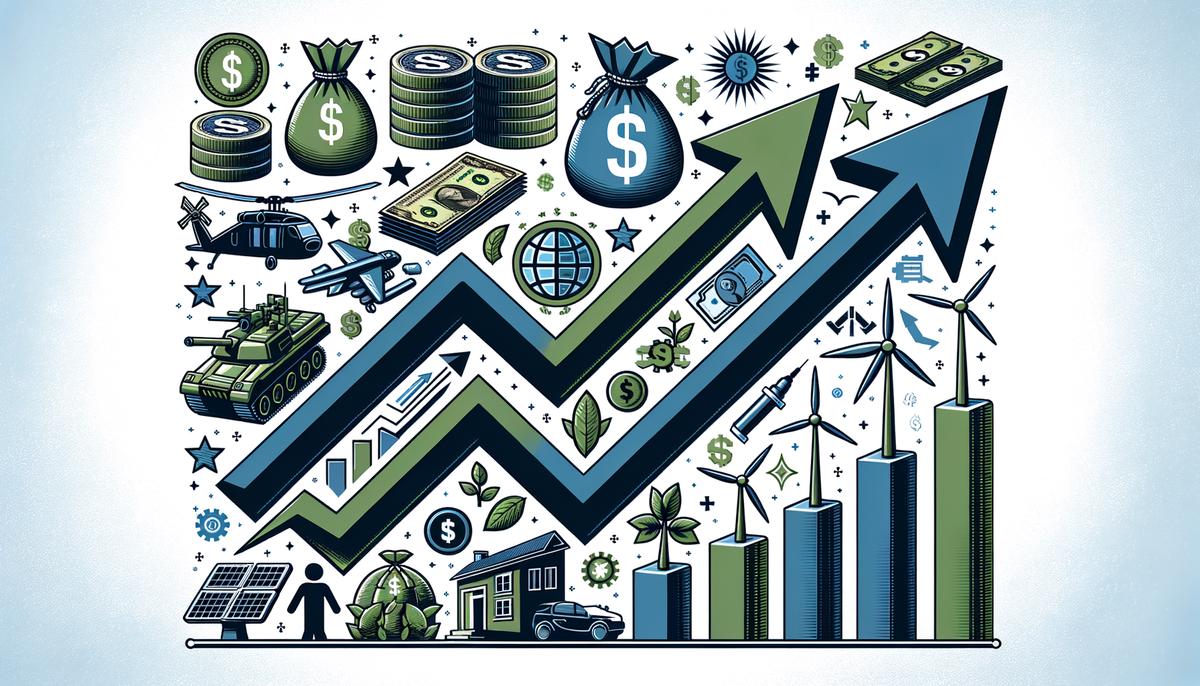Jamie Dimon, the CEO of JPMorgan Chase, recently shared insights that have caused a stir in the financial community. He suggested that US interest rates could soar above 8%, a level not seen since before the 1990s. Dimon's prediction stems from various inflationary pressures squaring off against the economic environment. Factors such as ongoing government spending, increased militarization worldwide, and shifts in global trade structures all contribute to this prognosis.
Dimon emphasized the impact of transitioning to a greener economy and the potential for higher future energy costs due to current underinvestment in energy infrastructure. These elements interact in a complex economic landscape that might further fuel inflation.
Dimon's assessment includes a broad range of possibilities for the US economy, from strong growth with moderate inflation to a scenario of stagflation, where a recession meets persistently high inflation rates. This spectrum of outcomes underscores Dimon's cautionary stance on optimism about falling interest rates.
JPMorgan is preparing for interest rates that might fluctuate between 2% and over 8%, reflecting a strategic plan that underscores the bank's readiness for various future states of the world economy.
Dimon paid particular attention to ongoing global shifts, including increased military expenditure and changes in trade relationships, which are influencing inflationary trends. Additionally, central bankers, including those at the Federal Reserve, are catching Dimon's eye with their policies on quantitative tightening to battle inflation without rushing to reduce rates.
Despite progress in combating inflation, which has dropped from peak levels, Dimon asserts that we are not out of the woods. He casts doubt on the market's expectation for interest rate reductions, pointing out that economic indicators might not support such optimism given sustained government spending during an economic boom, bolstered by previous stimulus measures.
Central to Dimon's narrative is a direct link between monetary policy, fiscal responsibility, and geopolitical developments. High government spending, not just in response to crises but as part of strategic investments in infrastructure and green initiatives, may maintain fiscal pressure, preserving the risk of inflation and potentially high interest rates for longer than markets currently anticipate.
JPMorgan's attentiveness to these signs and stressors, preparing for scenarios as varied as an interest rate of 8% or more, showcases thoughtful navigation of choppy economic waters. Jamie Dimon's reflections remind investors and policymakers alike of the unpredictability inherent in economic forecasting and the importance of readiness for a range of outcomes.
In the scenario Jamie Dimon outlines, where interest rates potentially climb above 8%, the forecast presents a significant challenge for both equity and debt investors. Higher interest rates usually lead to increased loan costs, causing consumers and businesses to reduce spending. This tightening of credit could result in lower profits for companies, particularly those reliant on borrowing to finance operations or expansion, thereby negatively impacting stock valuations.
For equity investors, Dimon's message suggests a re-evaluation of portfolio strategies. With stock valuations at the "high end," as Dimon remarked, the risk of market corrections increases as investors recalibrate their expectations in response to rising interest rates. Such a reevaluation could lead to increased market volatility, presenting both risks and opportunities that require careful navigation.
The fallout for debt investors is equally concerning. High interest rates elevate the cost of borrowing across an array of financial products, including mortgages, car loans, and credit card debt. For those holding bonds, the inverse relationship between bond prices and interest rates spells potential losses, as existing bonds with lower rates lose value compared to newly issued bonds with higher yields.
Amidst these investor challenges, the broader ramifications for the banking system are considerable. The acquisition of First Republic by JPMorgan, for example, underscores a banking environment under pressure, complicated by fluctuating interest rates. Such mergers and takeovers, while stabilizing in the short term, hint at underlying fragilities within the banking system that could be exacerbated by persistently high rates.
Tight credit conditions, part of Dimon's forecast, could further strain small to medium-sized banks that lack the 'fortress balance sheet' JPMorgan prides itself on. These institutions might find themselves squeezed between rising operating costs due to higher interest rates and the diminished capability of consumers and businesses to take on new debt. The scenario hints at a potential reshaping of the banking landscape, favoring larger, well-capitalized institutions capable of weathering financial upheavals.
Dimon's caution paints a picture of a finance world at a crossroads. While preparing for a broad range of outcomes is JPMorgan's strategy, for many investors and banks, navigating this uncertain future will require not only sound financial judgment but also resilience against the headwinds of change prompted by systemic shifts in interest rate policies. The landscape that emerges may well be testament to the adaptation and foresight exercised today in anticipation of tomorrow's challenges.

Dimon's critique of US government spending hints at a troubling spiral, where fiscal excess feeds inflation and bolsters high interest rates—a far cry from the economy's needs. Through his annual shareholder letter, Dimon expresses concern over what he perceives as a precarious path of large-scale deficit financing. The compulsion to finance an ambitious transition to a greener economy and the upscaling in military expenditures are aspects he underscores, posing a dual challenge to economic stabilization efforts.
This increasing government expenditure, according to Dimon, may exacerbate inflationary pressures. Inflating the money supply to cover these costs without creating substantive economic value can diminish the purchasing power of the dollar, leading to inflation. Dimon articulates a scenario where this trajectory of spending fails to acknowledge the parallel increase in borrowing costs, setting the stage for inflation that remains stubbornly high. The phenomenon is apparent in the rising consumer price index, echoing his concerns about "stickier inflation."
It is within this fiscal context that Dimon projects the possibility of interest rates rising beyond market forecasts. "It is important to note that the economy is being fueled by large amounts of government deficit spending," Dimon argues, indicating the economic tightrope walked by relying on borrowed affluence to sustain growth and investment. His call to heed the resultant pressures on interest rates mirrors a reality where market expectations for rate reductions might clash with the inflation battle's demands.
Dimon also discerns the implications of increasing military expenditure, spotlighting its notable share in shaping fiscal discourse. In conjunction with the thrust to instigate a green transition, these factors converge to form a complex overlay on economic policy. They signify not just an augmentation of the government portfolio but accentuate deeper implications for fiscal discourse and economic strategy, weaving a narrative of interconnected challenges that beset monetary policy pathways.
The envisioning of an economic environment, where higher-than-anticipated interest rates become a staple, is rooted in these expansive fiscal pursuits. Dimon leverages this understanding to emphasize preparedness, charting JPMorgan's navigational plotting amidst possible economic storms. This foresight stems from an acutely observed trajectory of governmental fiscal habits alongside their domino effects on the broader economy.
Dimon's exposition compels a shifting gaze towards how governing spending practices might recalibrate existing economic equations. It forces a strategic reevaluation, especially within the banking sector, to weather potentially high interest rate climates while advocating for a tempered approach to fiscal endeavor. As these conversations unfold, the spotlight intensifies on balancing economic ambitions with prudence, signaling divergent paths that policy might adopt in forestalling the persistence of "stickier inflation" and its accompanying challenges.
Dimon stays grounded in a reality check for the federal purse. His discourse conveys not just a call for caution but an urgent push for a recalibrated fiscal strategy that aligns with sustainable economic health objectives. The exposition presents a layered critique pivoting around governance, monetary policy, and fiscal prudence entwined within the complex tapestry of economic forecasting and present-day decisions.

- Dimon J. Chairman & CEO Letter to Shareholders. JPMorgan Chase & Co. 2022.
- Cox J. Jamie Dimon says brace yourself for an economic 'hurricane'. CNBC. June 1, 2022.
- Tappe A. JPMorgan's Jamie Dimon cautions a recession could be coming. Here's how it could play out. CNN Business. October 12, 2022.
- Winck B. Get ready for a decade of lower stock market returns as interest rates rise, JPMorgan says. Business Insider. April 16, 2023.
- Reeves M, Varadarajan R. We Need to Talk About Inflation. Harvard Business Review. September–October 2022.
Get high quality content with Writio, the AI content writer for blogs and websites. This article was written by Writio.
Leave a Reply